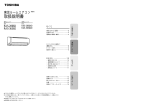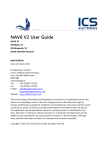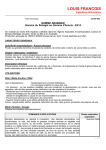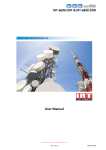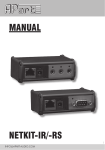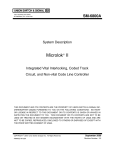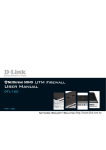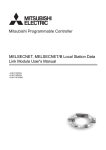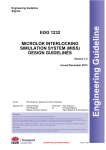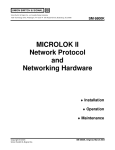Download SM-6800F ASES Interface Board - Ansaldo STS | Product Support
Transcript
SM-6800F AN ANSALDO SIGNAL COMPANY 1000 Technology Drive Pittsburgh, PA 15219-3120 645 Russell Street Batesburg, SC 29006 ASES Interface Board MICROLOK II Integrated Vital Interlocking, Coded Track Circuit, and Non-vital Code Line Controller (Addendum to SM 6800A-E) COPYRIGHT © 2003 UNION SWITCH & SIGNAL PRINTED IN USA August 2003 Revision 1.0 IUNION SWITCH & SIGNAL I[fil] SM-6800F August 2003, Rev. 1.0 PROPRIETARY NOTICE This document and its contents are the property of Union Switch & Signal Inc. (hereinafter US&S). This document has been furnished to you on the following conditions: no right or license under any patents or any other proprietary right in respect of this document or its content is given or waived in supplying this document. This document or its content are not to be used or treated in any manner inconsistent with the rights of US&S, or to its detriment, and are not to be copied, reproduced, disclosed to others, or disposed of except with the prior written consent of US&S. IMPORTANT NOTICE US&S constantly strives to improve our products and keep our customers apprised of changes in technology. Following the recommendations contained in the attached document will provide our customers with optimum operational reliability. The data contained herein purports solely to describe the product, and does not create any warranties. Within the scope of the attached document, it is impossible to take into account every eventuality that may arise with technical equipment in service. Please consult US&S's local sales representative in the event of any irregularities with our product. We expressly disclaim liability resulting from any improper handling or use of our equipment, even if these instructions contain no specific indication in this respect. We strongly recommend that only approved US&S spare parts be used as replacements. Copyright © 2003, Union Switch & Signal, Inc An Ansaldo Signal Company All rights reserved. August 2003, Rev. 1.0 SM-6800F i REVISION INDEX ii REV ISSUE DATE 0.0 10/02 0.1 7/28/03 1.0 8/4/03 REVISION DESCRIPTION APPROVAL DATE First release. Revisions per ECO # 13139881-2. Standard manual reformat. Revisions per FTR. SM-6800F 8/1/03 August 2003, Rev. 1.0 TABLE OF CONTENTS 1 GENERAL INFORMATION................................................................................... 1-1 1.1 Introduction .................................................................................................................................1-1 1.2 Rail Team and Technical Support .............................................................................................1-2 2 GLOSSARY .......................................................................................................... 2-1 3 FUNCTIONAL DESCRIPTION ............................................................................. 3-1 3.1 Introduction .................................................................................................................................3-1 3.1.1 Front Panel Description ........................................................................................................3-2 3.1.2 Upper-Rear Connector .........................................................................................................3-4 3.1.3 Lower-Rear Connector .........................................................................................................3-4 3.1.4 Keying Plug Installation ........................................................................................................3-4 3.1.5 ASES Interface to Service Entrance Wiring .........................................................................3-7 3.1.6 Service Entrance Surge and Transient Protection ...............................................................3-7 3.1.7 Service Entrance to Transponder Wiring .............................................................................3-7 4 PART NUMBERS ................................................................................................. 4-1 5 OPERATING PARAMETERS ............................................................................... 5-1 6 APPLICATION LOGIC.......................................................................................... 6-1 6.1 Board Type ASES.ENCODER....................................................................................................6-1 6.1.1 Notes on Card Definitions.....................................................................................................6-2 6.1.2 Example Telegram ...............................................................................................................6-3 6.1.3 Example Channel Definitions for an ASES Board ................................................................6-3 6.1.4 Telegram Generation and Checking ....................................................................................6-4 7 7.1 8 ACCESSING ASES INFORMATION FROM THE CPU BOARD .......................... 7-1 Viewing Encoder Channel Telegrams for an ASES Interface Board......................................7-1 Configuring Boards and Displaying Status Information ................................. 8-1 8.1 Configuring ASES Boards..........................................................................................................8-1 8.2 Viewing the ASES Board Status Display ..................................................................................8-3 9 TROUBLESHOOTING ASES INTERFACE OPERATIONS ................................. 9-1 9.1 Transponder Tester L34100 .......................................................................................................9-1 9.2 MICROLOK II Development System ..........................................................................................9-2 August 2003, Rev. 1.0 SM-6800F iii LIST OF FIGURES Figure 3-1. ASES Interface Between MICROLOK II and Transponders ......................................................3-1 Figure 3-2. ASES Interface Board Front Panel .........................................................................................3-3 Figure 3-3. MICROLOK II Cardfile Slot Keying Plug Installation...................................................................3-5 Figure 3-4. Connection Diagram for the Upper-Rear Connector ..............................................................3-6 Figure 7-1. CPU Board Displays and Toggle Switches.............................................................................7-1 Figure 7-2. "ASES|BRDS" in CPU Board Displays....................................................................................7-2 Figure 8-1. "ASES_ENCODER" Button on a System Configuration Screen.............................................8-1 Figure 8-2. ASES Interface Board Configuration Screen..........................................................................8-2 Figure 8-3. Confirmation Dialog Box on ASES Interface Board Configuration Screen .............................8-3 Figure 8-4. "ASES_ENCODER" Button on a Board Information Screen ..................................................8-4 Figure 8-5. ASES Interface Board Status Screen .....................................................................................8-4 LIST OF TABLES Table 3-1. Front Panel LED States and Descriptions ...............................................................................3-2 Table 3-2. MICROLOK II Cardfile Motherboard Keying Plug Locations .......................................................3-4 Table 4-1. ASES Part Numbers ................................................................................................................4-1 Table 5-1. ASES Interface Board Operating Parameters .........................................................................5-1 Table 9-1. Telegram Information and Trouble-Sources ............................................................................9-1 iv SM-6800F August 2003, Rev. 1.0 Section 1 General Information 1 GENERAL INFORMATION 1.1 Introduction This manual will provide sufficient information for users to correctly install one or more ASES (Advanced Speed Enforcement System) interface boards into a MICROLOK II cardfile. Additional information about application logic, telegram generation, and application checking and compiling is also provided. For reference, related MICROLOK II system manuals include: • SM-6800A - MICROLOK II System Description • SM-6800B - MICROLOK II System Hardware Installation Manual • SM-6800C - MICROLOK II System Startup, Troubleshooting, and Maintenance • SM-6800D - MICROLOK II System Application Logic Programming • SM-6800E - MICROLOK II, ECode and i-Lok Features Description Other manuals that provide information on related US&S systems include: • SM-6700A - GENISYS-2000 Multi-Purpose Non-vital Control/Communications System (Application Logic Programming) • SM-6700B - GENISYS-2000 Multi-Purpose Non-vital Control/Communications System Hardware Installation and Configuration • SM-6470A - MicroTrax Coded Track Circuit System Application Logic Programming • SM-6470B - MicroTrax Coded Track Circuit System Hardware Installation and Configuration US&S provides no shop maintenance procedures for the MICROLOK II system circuit boards. These boards are not repairable in the field. MICROLOK is a registered trademark of Union Switch and Signal ECode i-Lok is a registered trademark of Union Switch and Signal is a registered trademark of Union Switch and Signal GENISYS is a registered trademark of Union Switch and Signal MicroTrax is a registered trademark of Union Switch and Signal August 2003, Rev. 1.0 SM-6800F 1-1 Section 1 General Information 1.2 Rail Team and Technical Support The Rapid Action Information Link (RAIL) team was created in 1996 to serve the technical needs of current and potential US&S customers. Convenient, 24-hour access and a rapid resolution to customer problems are the trademarks of this organization. The RAIL team, which is staffed primarily by US&S product and application engineers, is ready to assist and resolve any technical issues concerning the MICROLOK II system or any other US&S product. Any questions regarding the contents of this service manual should be directed to the RAIL team by telephone at 1-800-652-7276 or through Internet e-mail at [email protected]. 1-2 SM-6800F August 2003, Rev. 1.0 Section 2 Glossary 2 GLOSSARY The information below defines selected terms and abbreviations that appear in this document. TERM/ABBREVIATION DEFINITION ASES Advanced Speed Enforcement System ATSS AT Systems AB. ATSS is a Swedish company engaged in the design, engineering, production, and distribution of automated train protection systems for rail-based transportation. Channel A path along which an electrical signal passes. Circular Shift Register A device comprised of multiple ICs that has the ability to receive, transmit, and reload transmitted data on a first in, first out basis. CRC Cyclic Redundancy Check. The check consumes 64 bits of the message, and it is used to ensure the integrity of the telegram. Critical Error A software-detected fault that initiates a system shutdown. Diagnostic Buffer A register used to store a telegram until it can be read by the processor for the purpose of checking the telegram's integrity. Diagnostic Error An error generated when the diagnostic routine detects a corrupted telegram in the diagnostic buffer. Service Entrance An entrance into a wayside control hut through which wiring passes. Telegram A 255-bit message. Telegram Compiler A program that converts a text file of the user programmed data inputs into a 255-bit telegram that is used by the system. August 2003, Rev. 1.0 SM-6800F 2-1 IUNION SWITCH & SIGNAL I[fil] Section 2 Glossary 2-2 SM-6800F August 2003, Rev. 1.0 Section 3 Functional Description 3 FUNCTIONAL DESCRIPTION 3.1 Introduction The ASES Interface Board serves as an interface between the MICROLOK II system and ATSS transponders. The board consists of five independent encoder channels. Each channel is capable of accepting and storing a 255-bit telegram from the MICROLOK II processor board. When the channel is activated, the telegram is converted to a serial format compatible with the ATSS transponder protocol, and continuously transmitted to the transponder. A typical example is shown in Figure 3-1. The example shown uses channels one, two, and five of the ASES Interface Board. Channels 3 and 4 are not used. Any combination of the five available channels can be used. Processor Board MC68332 Backplane Outputs 3 and 4 Unused ASES Interface Board MicroLok II Cardfile Train Transponder 1 L34000 Transponder 2 L34000 Transponder 5 L34000 Figure 3-1. ASES Interface Between MICROLOK II and Transponders August 2003, Rev. 1.0 SM-6800F 3-1 Section 3 Functional Description NOTE The ASES Interface Board has no user-adjustable features. 3.1.1 Front Panel Description The ASES Interface Board front panel is shown in Figure 3-2. Each of the five red LEDs provides information about a single channel and is labeled with the corresponding channel number for clarity. The LED corresponding to Channel 1 is at the top of the front panel, and the LED corresponding to Channel 5 is at the bottom. During operation, the LEDs appear in one of two states: "off "or "flashing." The two states are described in Table 3-1. Table 3-1. Front Panel LED States and Descriptions STATE DESCRIPTION The channel is not in use. Off Flashing 3-2 Possible reasons include no telegrams being sent through that channel, or that a critical error has occurred. The channel is actively transmitting a telegram with no diagnostic errors. SM-6800F August 2003, Rev. 1.0 Section 3 Functional Description Figure 3-2. ASES Interface Board Front Panel August 2003, Rev. 1.0 SM-6800F 3-3 Section 3 Functional Description 3.1.2 Upper-Rear Connector The upper-rear connector is a 48-pin DIN 41612 Type E connector used for field wiring. Pins on this connector also supply the board with its cardfile slot address, which is assigned via jumpers that reside inside the cardfile-mounted housing of the connector's mating half. Note that the jumper settings must match the board address found in the .mll application file listing. Details for correctly installing the jumpers (as well as additional information about the upper connector) can be found in the MICROLOK II Hardware Installation manual (document number SM-6800B). A connection diagram for the upper-connector is shown in Figure 3-4. If a user does not wish to employ all five channels for a given application, any combination of channels can be used and they do not have to be connected in sequential order. For example, an application requiring only two channels could use Channel 1 and Channel 4. 3.1.3 Lower-Rear Connector The lower-rear 96-pin DIN connector on the ASES Interface PCB plugs into the MICROLOK II cardfile motherboard to interface with the internal bus system. Mounted alongside the connector is the twelve-tab male keying strip. Tabs on this keying strip are removed at the factory according to a specific pattern, which identifies the particular PCB. PCB keying information is shown on US&S drawing D451019, sheet 7607. 3.1.4 Keying Plug Installation Each MICROLOK II cardfile motherboard has a 96-pin lower connector for each PCB slot. A female keying guide is installed alongside the connector. At the field location, once the cardfile PCB configuration has been determined, the guide is used to ensure proper PCB placement in the cardfile. Keying plugs (Part # J709146-0473) are inserted into the MICROLOK II cardfile motherboard keying guide to match the tab pattern of the particular PCB to be installed into that cardfile slot. Table 3-2 lists the keying plug locations for a slot occupied by an ASES Interface PCB. Figure 3-3 illustrates the process of keying plug installation. A pair of needle nose pliers can be used to remove a keying plug in the event one should need to be removed. Table 3-2. MICROLOK II Cardfile Motherboard Keying Plug Locations KEYING PLUG LOCATION (FIGURE 3-3) PRINTED CIRCUIT BOARD ASES INTERFACE 3-4 PART NO. N17064401 1 2 ✔ SM-6800F 3 4 5 ✔ ✔ ✔ 6 7 8 9 10 11 ✔ ✔ 12 August 2003, Rev. 1.0 Section 3 Functional Description 96-pin (Female) Connector on Cardfile Motherboard Keying Plug No. 96-pin (Male) Connector on PCB Insert Keying Plug J709146-0473 Per Table 3-2 1 ■■■ ■■■ 2 ■■■ ■■■ ■■■ 3 ■■■ ■■■ ■■■ 4 ■■■ ■■■ ■■■ 5 ■■■ ■■■ ■■■ 6 ■■■ ■■■ 7 ■■■ ■■■ Printed Circuit Board ■■■ 8 ■■■ ■■■ ■■■ 9 ■■■ ■■■ ■■■ 10 ■■■ ■■■ ■■■ 11 ■■■ ■■■ ■■■ 12 ■■■ Adjacent Keying Plug Connector (Female) Adjacent Keying Plug Connector (Male) PCB Keying Tabs Set at Factory Figure 3-3. MICROLOK II Cardfile Slot Keying Plug Installation August 2003, Rev. 1.0 SM-6800F 3-5 Section 3 Functional Description 48-pin Connector I/O E8 + To Transponder #1 C8 - Channel #1 N17064401 C12 + To Transponder #2 A12 E16 + To Transponder #3 C16 C20 + To Transponder #4 A20 E24 + To Transponder #5 C24 - Channel #2 Channel #3 ASES INTERFACE PCB Channel #4 Channel #5 NOTE The vital power source for the ASES Interface Board is different from the vital power source for all other MICROLOK II I/O Boards. The ASES Board requires a dedicated set of VCOR contacts to break +12VDC from the MICROLOK II system power supply (not B12). Because of the low current draw (max. 300 ma per ASES Board), one set of VCOR contacts may be used to feed multiple ASES Boards within a cardfile. +12V VCOR Relay A2, C2, E2 System +12VDC SEL+ SW1 SW2 SW3 SW4 SW5 SW6 Address GND Select PCB E32 SEL+ E30 ADDRSEL 4 C30ADDRSEL 5 A30ADDRSEL 6 E28 ADDRSEL 7 C28ADDRSEL 8 A28ADDRSEL 9 C26GND CONNECTIONS TO PCB ADDRESS SELECT CIRCUITS Figure 3-4. Connection Diagram for the Upper-Rear Connector 3-6 SM-6800F August 2003, Rev. 1.0 Section 3 Functional Description The ADDRSEL4 - ADDRSEL9 pins are connected through placement of jumpers on the upper-connector PCB. The Ground and SEL+ pins are connected appropriately when the upper-connector is installed. The only connections to make, therefore, are to the CHn + and CHn - pins ("n" = 1 through 5), and to the +12V pins from the MICROLOK II system power supply. 3.1.5 ASES Interface to Service Entrance Wiring To minimize the effects of noise, US&S recommends the use of twisted-pair wiring between the ASES Interface Board (48-pin top PCB connector) and the equipment rack terminal strip. Twisted pair wiring should continue to the house service entrance panel. 3.1.6 Service Entrance Surge and Transient Protection US&S recommends that each transponder wire be protected with a Line-to-Ground Arrester, and that each pair of transponder wires be protected by a Line-to-Line Arrester. The US&S part numbers are: • Line-to-Ground Arrester – USGA Red; part number N451552-0201 • Line-to-Line Arrester – USGA Blue; part number N451552-0101 3.1.7 Service Entrance to Transponder Wiring For cabling from the service entrance to the transponder, use US&S part number A045849-0314. The connector at the transponder end is Amphenol part number 162-5040-12-10-SN. August 2003, Rev. 1.0 SM-6800F 3-7 IUNION SWITCH & SIGNAL I[fil] Section 3 Functional Description 3-8 SM-6800F August 2003, Rev. 1.0 Section 4 Part Numbers 4 PART NUMBERS Table 4-1 lists the part numbers associated with ASES. Table 4-1. ASES Part Numbers PART NUMBER DESCRIPTION NOTES N17064401 MICROLOK II ASES Interface Board -- N451232-1701 MICROLOK II Executive Version 5.20 and higher - includes support for ASES and ECode transit codes. N451232-1781 MICROLOK II Development System Version 5.20 and higher - includes support for ASES and ECode transit codes. TRANEDIT, Full Version Software used to compile text files to a binary message utilized by the encoders/transponders. It can also be used to decompile binary data into a text format. Cable assembly PCB 48-pin top connector with cable length as specified by project. N451232-2606 *N50761101 (* 10ft cable) August 2003, Rev. 1.0 SM-6800F 4-1 IUNION SWITCH ,& SIGNALjmi] Section 4 Part Numbers 4-2 SM-6800F August 2003, Rev. 1.0 Section 5 Operating Parameters 5 OPERATING PARAMETERS Table 5-1 lists the ASES Interface Board's operating parameters. Table 5-1. ASES Interface Board Operating Parameters PARAMETER RANGE Supply Voltage * +5VDC and +12VDC Operating Temperature - 40!C to + 70!C Humidity 0% to 95% non-condensing 170 mA total at +5 VDC Current Draw 60 mA at +12 VDC for each channel in use (5 channels x 60 mA = 300 mA maximum) 0 milliamp at –12 VDC * Derived from the MICROLOK II system power supply. August 2003, Rev. 1.0 SM-6800F 5-1 IUNION SWITCH ,& SIGNALjmi] Section 5 Operating Parameters 5-2 SM-6800F August 2003, Rev. 1.0 Section 6 Application Logic 6 APPLICATION LOGIC 6.1 Board Type ASES.ENCODER Address Class: 8 Bit VPA Formatting for the telegram message encoding. For this board the formatting is as follows: TYPE: ASES.ENCODER CHANNEL1: [[ADJUSTABLE | FIXED] ENABLE: <flag>;] [SEND "<telegram 1>" IF <control bit 1>, "<telegram 2>" IF <control bit 2>, … "<telegram n>" IF <control bit n>;] CHANNEL2: [[ADJUSTABLE | FIXED] ENABLE: <flag>;] [SEND "<telegram 1>" IF <control bit 1>, "<telegram 2>" IF <control bit 2>, … "<telegram n>" IF <control bit n>;] CHANNEL3: [[ADJUSTABLE | FIXED] ENABLE: <flag>;] [SEND "<telegram 1>" IF <control bit 1>, "<telegram 2>" IF <control bit 2>, … "<telegram n>" IF <control bit n>;] August 2003, Rev. 1.0 SM-6800F 6-1 Section 6 Application Logic CHANNEL4: [[ADJUSTABLE | FIXED] ENABLE: <flag>;] [SEND "<telegram 1>" IF <control bit 1>, "<telegram 2>" IF <control bit 2>, … "<telegram n>" IF <control bit n>;] CHANNEL5: [[ADJUSTABLE | FIXED] ENABLE: <flag>;] [SEND "<telegram 1>" IF <control bit 1>, "<telegram 2>" IF <control bit 2>, … "<telegram n>" IF <control bit n>;] 6.1.1 Notes on Card Definitions • A maximum of two ASES.ENCODER boards (up to a control of 10 transponders) may be defined in each application. 6-2 • If an enable statement is not supplied for a channel, it will be given a default configuration of FIXED ENABLE: 0. • The CHANNEL1: through CHANNEL5: keywords must all be present. • A maximum of twelve telegrams can be defined in each channel. • Telegrams are 32 byte hex strings that must be enclosed in quotations. These strings are created using an external telegram compiler. There is an example telegram shown in Section 6.1.2 below. • The compiler verifies the length of the telegram. The compiler ignores white spaces and verifies that there are sixty-four characters. • The compiler verifies that all telegrams are unique to the application. • The compiler verifies the telegram through a telegram checker. (For more information, see Section 6.1.4, "Telegram Generation and Checking.") SM-6800F August 2003, Rev. 1.0 Section 6 Application Logic 6.1.2 Example Telegram An example telegram is shown below: " 3ABF 86C1 D886 0312 AFFE 3383 0DBF F008 7878 7878 7878 7904 79EB B18F C81E 061C " 6.1.3 Example Channel Definitions for an ASES Board This example demonstrates how to use the ASES board. It sets up the five channels in different ways. Although there are no telegrams defined for channel 3, the channel still must be specified. Up to twelve telegrams can be defined for each channel. In this example, channel 5 has the maximum number of telegrams. When multiple telegrams are selected for any given channel, the first selected telegram for the channel is the telegram that is transmitted. Channels 3 and 4 are disabled, so those channels are not transmitting any telegram. Channel 2 is enabled, but no telegram is selected, therefore it transmits the NULL telegram. The NULL telegram consists of all zeroes, which makes the transponder transmit its own default telegram. MICROLOK_II PROGRAM ASES_example; INTERFACE LOCAL BOARD: ASES_ENCODER ADJUSTABLE ENABLE: 1 TYPE: ASES.ENCODER CHANNEL1: ADJUSTABLE ENABLE: 1 SEND "3ABF 86C1 D886 0312 C81E 061C" IF as11, "7BBF 86C1 D907 7841 42C2 5EF1" IF as12, "7BBF 86C1 D907 7843 996E DBAD" IF as13; CHANNEL2: ADJUSTABLE ENABLE: 1 SEND "7A4C 86C2 6787 7867 60ED B11B" IF as21; CHANNEL3: CHANNEL4: ADJUSTABLE ENABLE: 0 SEND "7BBF 86C1 D907 7846 B72F 82E6" IF as41; CHANNEL5: ADJUSTABLE ENABLE: 1 SEND "7A53 06C3 6DC7 7862 3D73 DAC8" IF as51, "7A53 06C3 6DC7 7867 1332 8383" IF as52, "7A53 06C3 6DC7 786F 185C 9AE7" IF as53, August 2003, Rev. 1.0 AFFE 3383 0DBF F008 7878 7878 7878 7904 79EB B18F 1FFA 18BF FF43 1643 564B 4050 0878 7BC9 5F43 8A4F 1FFA 18BF FF43 1643 564B 4050 0878 79D6 FEAD 07D5 0579 F880 6842 0E43 1008 7878 7878 79EF 92B9 99A0 1FFA 18BF FF43 1643 564B 4050 0878 7998 46B7 0EDE 0645 B880 9ABB 1643 1008 7878 7878 7943 B710 396E 0645 B880 9ABB 1643 1008 7878 7878 790D 0F0A 3065 0645 B9C0 9ABB 1643 1008 7878 7878 7D44 0E33 F35C SM-6800F 6-3 Section 6 Application Logic "1A5E 46C3 AC87 3862 03DA 1880 A4B3 1603 1008 7878 7878 796D 2147 CBF0 CD8A DD9D" IF as54, "1A5E E3CB 84D6" IF "1A5E 7857 2356" IF "5A5D 0768 3B4F" IF "3A5E F577 7285" IF 46C3 AC87 as55, 46C3 AC87 as56, C6C3 AD06 as57, 06C3 AC86 as58, 3867 03DA 1880 A4B3 1603 1008 7878 7878 7923 995D C2FB "7A5E 6E73 5C57" IF "7A5E 750B 2930" IF "7A5E 7E65 3054" IF "1A72 63ED 1ADD" IF 46C3 AD07 as59, 46C3 AD07 as5a, 46C3 AD07 as5b, C6C3 EB87 as5c; 7862 03DD B8BC C8B7 1643 1008 7878 7878 79E2 DA20 AD7F 386F 03DA 19C0 A4B3 1603 1008 7878 7878 790D 445B BBAB 4312 EFFE 2B84 0DBF F2EA 8923 830D CD00 4995 A9B8 9895 0312 AFFE 2B84 0D9F F2A9 BF1B 830D 80A8 496E B5D1 2421 7867 03DD B880 C8B7 1643 1008 7878 7878 7D5D 47F6 BD93 786F 03DD B9C0 C8B7 1643 1008 7878 7878 7914 46CF 7EAA 3862 0525 9880 2D43 1603 1008 7878 7878 79AE AB6E A32D LOGIC BEGIN ASSIGN 1 TO CPS.ENABLE; ASSIGN 1 TO as13; ASSIGN 1 TO as12; ASSIGN 0 TO as21; ASSIGN 1 TO as41; ASSIGN 1 to as5c; NV.ASSIGN ASES_ENCODER.Channel5Enable TO LED.1; END LOGIC END PROGRAM 6.1.4 Telegram Generation and Checking An external telegram compiler is used to create the telegrams. This software, TRANEDIT, was developed by ATSS. After the telegrams have been produced, they are copied into the MICROLOK II Application Source program. As part of the MICROLOK II Application Logic compilation process, the telegrams are checked for validity. If a telegram does not pass the basic 64-bit CRC check, the compiler rejects it. Additional tests are performed to ensure that the various telegrams are unique. (For example, if a telegram defined for Channel 1 would also be valid for another channel on that board, the compiler will flag the condition as an error. In such cases, either the content or format of the telegram must be changed using TRANEDIT.) 6-4 SM-6800F August 2003, Rev. 1.0 Section 7 Accessing ASES Information from the CPU Board 7 ACCESSING ASES INFORMATION FROM THE CPU BOARD 7.1 Viewing Encoder Channel Telegrams for an ASES Interface Board The ASES interface board option, available via the CPU board, enables you to view the telegrams being transmitted for a selected ASES interface board. The procedure in this section describes how to select an ASES interface board and view the available data. The LEDs on the ASES interface board report the state of their corresponding channels. Any additional interface board information must be obtained by using the unit's CPU board. The CPU board features two, four-character displays, as well as four toggle switches for determining the data that appears in the displays. These elements are illustrated below: Figure 7-1. CPU Board Displays and Toggle Switches Follow the steps below to display ASES interface board information: 1. Using the CPU board's toggle switches, toggle the board's displays until "ASES | BRDS" appears, as shown in Figure 7-2. August 2003, Rev. 1.0 SM-6800F 7-1 Section 7 Accessing ASES Information from the CPU Board Figure 7-2. "ASES|BRDS" in CPU Board Displays 2. With "ASES | BRDS" showing on the CPU board displays, toggle the MENU UP-DOWN switch to the "DOWN" position. The CPU board displays will show "ASES | BRDn", indicating the selection of one of the installed ASES interface boards. Note that the menu is configured for one or two ASES interface boards. 3. To change the ASES interface board selection, toggle the MENU L-R switch as necessary until the desired ASES interface board number is indicated in the lower display. 4. Toggle the MENU UP-DOWN switch to the "DOWN" position to display the Telegram status of the first channel for the selected ASES interface board. The channel information, which will be shown in the lower display, can be as follows: • "DISABLED" – channel is disabled and not transmitting telegrams • "NULL" – channel is active and transmitting a "NULL" telegram • "XXXX XXXX XXXX .." – channel is active and a telegram is being transmitted 5. To change the channel selection, toggle the MENU L-R switch as necessary until the desired channel number is indicated in the upper display. 7-2 SM-6800F August 2003, Rev. 1.0 Section 8 Configuring Boards and Displaying Status Information 8 Configuring Boards and Displaying Status Information The MICROLOK II laptop computer-based Development System program provides two options related to ASES boards: • Configuring ASES boards • Displaying ASES board status information The options are described in the sections below. 8.1 Configuring ASES Boards The Development System provides options for system-configuration activities. On the program's "System Configuration" screen, the button indicated in Figure 8-1 initiates board configuration. Figure 8-1. "ASES_ENCODER" Button on a System Configuration Screen The screen will display one or two selection buttons, depending on how many ASES interface boards are being used. You can configure an ASES interface board by clicking on the appropriate selection button. The configuration activities you can perform include: • Enabling or selectively disabling a particular board • Enabling or selectively disabling one or more board channels August 2003, Rev. 1.0 SM-6800F 8-1 Section 8 Configuring Boards and Displaying Status Information NOTE The board and channel ENABLE options are user-configurable via the Development System program only if the options are identified as adjustable parameters in the application software. The procedure below describes an example of configuring an ASES interface board. 1. To configure an ASES interface board, click on one of the selection buttons on the System Configuration selection screen. The dialog box shown in Figure 8-2 appears. Figure 8-2. ASES Interface Board Configuration Screen 2. Ensure that a check mark appears in the "ENABLE" selection box at the top of the screen. If necessary, click on the "ENABLE" selection box to insert a check mark. 3. Ensure that a check mark appears in the selection box for each channel that is active. As needed, click on the empty selection box next to a channel you wish to activate; a check mark appears to indicate that the channel is active. (You can also click on boxes with check marks to remove the marks and deactivate the channels.) 4. After the board has the proper values for the application, click on the "DONE" button in the lower-left corner of the screen. The dialog box shown in Figure 8-3 appears. 8-2 SM-6800F August 2003, Rev. 1.0 Section 8 Configuring Boards and Displaying Status Information Figure 8-3. Confirmation Dialog Box on ASES Interface Board Configuration Screen The dialog box lists the changes you have initiated and requests you to confirm them. 5. Click on the "YES" button to complete the board configuration. The system redisplays the system configuration selection screen. 6. Repeat the steps above if there is another ASES interface board in the cardfile to be configured. 8.2 Viewing the ASES Board Status Display In addition to providing system-configuration activities, the Development System allows users to view the ASES board status displays. On the program's "Board Information" screen, the button indicated in Figure 8-4 initiates the viewing of a board's status. August 2003, Rev. 1.0 SM-6800F 8-3 Section 8 Configuring Boards and Displaying Status Information Figure 8-4. "ASES_ENCODER" Button on a Board Information Screen The screen will display one or two selection buttons, depending on how many ASES interface boards are being used. You can display status information for an ASES interface board by clicking on the appropriate selection button. The procedure below describes an example of displaying status information for an ASES interface board. 1. To display status information for an ASES interface board, click on one of the selection buttons on the Board Information screen. Status information appears for the board as shown in Figure 8-5. Figure 8-5. ASES Interface Board Status Screen 8-4 SM-6800F August 2003, Rev. 1.0 Section 8 Configuring Boards and Displaying Status Information The screen reports which channels are disabled, and shows telegram messages being transmitted on the enabled channels. To remove the interface board status screen, note that you must click on the "Back" button at the top of the window. 2. After you have completing viewing status information for the selected interface board, click on the "Back" button to return to the Board Information screen. 3. Repeat the steps above if there is another ASES interface board in the cardfile for which you wish to view status information. August 2003, Rev. 1.0 SM-6800F 8-5 Section 8 Configuring Boards and Displaying Status Information 8-6 SM-6800F IUNION SWITCH ,& SIGNALjmi] August 2003, Rev. 1.0 Section 9 Troubleshooting ASES Interface Operations 9 TROUBLESHOOTING ASES INTERFACE OPERATIONS There are four hardware elements necessary for the successful transmission of the correct ASES telegram from the wayside to an on-board train operator: • MICROLOK II Cardfile, including I/O boards and ASES Interface Board • Wiring between MICROLOK II and the wayside transponder • Wayside transponder • On-board vehicle equipment There are two tools, which are helpful in troubleshooting the above equipment: • Transponder Tester L34100 • MICROLOK II Development System 9.1 Transponder Tester L34100 The Transponder Tester, when placed above the wayside transponder, queries the transponder and records the telegram being transmitted. The telegram information may be used to pinpoint the trouble-source as shown in Table 9-1. Table 9-1. Telegram Information and Trouble-Sources TELEGRAM INFORMATION SOURCE OF PROBLEM The correct telegram is present. The on-board vehicle equipment is faulty. No telegram is present. The transponder is faulty. (Operation of the transponder can be verified by using the "Check Transponder" feature of the Transponder Tester). Either the wiring to MICROLOK or some element within the MICROLOK cardfile is faulty, or the transponder is faulty. The default telegram is present when the ASES Interface Board is active. Faulty wiring may be ruled out by checking for the presence of opens or shorts. Operation of the transponder can be verified by using the "Check Transponder" feature of the Transponder Tester. August 2003, Rev. 1.0 SM-6800F 9-1 Section 9 Troubleshooting ASES Interface Operations 9.2 MICROLOK II Development System The operation of the MICROLOK II Development System is described elsewhere in this manual. Two features are of particular use for troubleshooting include: • System Event Log – Indicates the presence of any faulty MICROLOK PCBs • Board Information – Displays the actual telegram selected for transmission to the wayside transponder. NOTE There are certain faults in the output driver stages of the ASES Interface PCB that are not detectable by the MICROLOK diagnostic software and, thus, will not visible with the Development System; therefore, if everything else checks out properly, swap the ASES Interface PCB with a known good board. 9-2 SM-6800F August 2003, Rev. 1.0 IUNION SWITCH & SIGNAL I[fil] August 2003, Rev. 1.0 Section 9 Troubleshooting ASES Interface Operations SM-6800F 9-3 Section 9 Troubleshooting ASES Interface Operations End of Manual 9-4 SM-6800F August 2003, Rev. 1.0







































